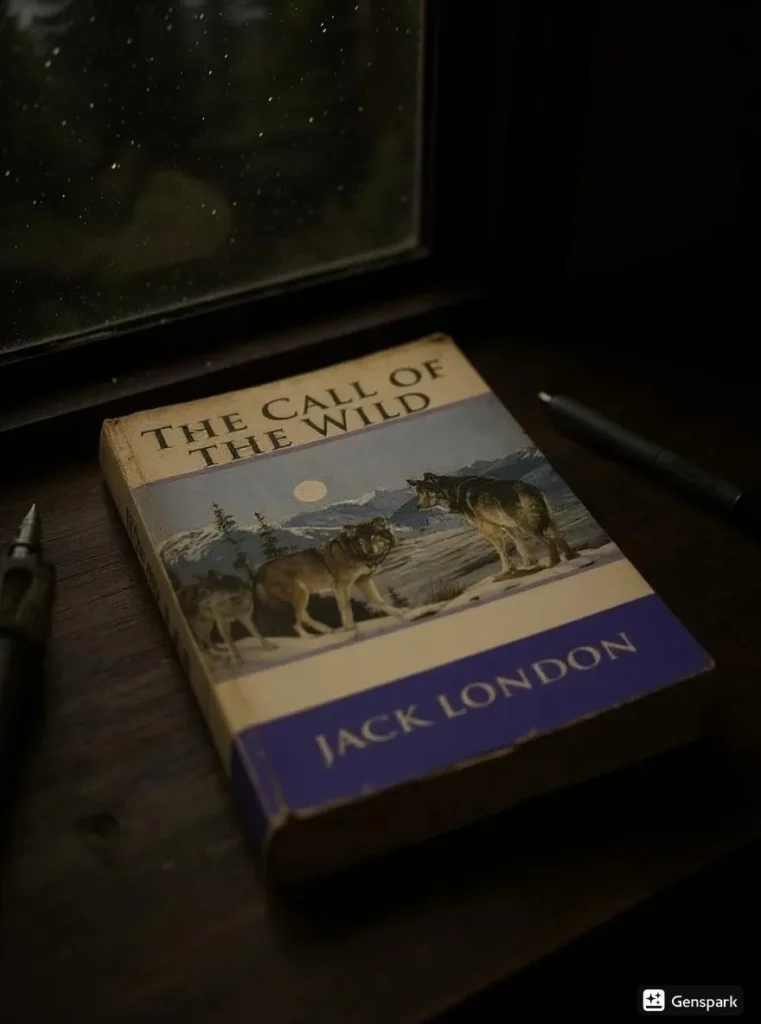I grabbed The Call of the Wild on a frigid December morning when my heating broke, and London’s brutal Yukon descriptions made my apartment feel tropical. I devoured this 95-page masterpiece in one sitting, clutching my coffee mug like Buck clinging to survival. London’s raw honesty about primal instincts left me questioning everything I thought I knew about civilization.
This 1903 classic follows Buck, a pampered St. Bernard-Scotch Collie mix, as he transforms from house pet to legendary wild creature. I’ve read thousands of adventure novels, but none capture the psychological brutality of survival like London’s masterpiece. Buck’s journey mirrors our own suppressed wildness – the part of us that civilization tries to tame but never fully conquers.
What mentally scarred me was London’s refusal to romanticize Buck’s transformation. This isn’t a Disney tale where animals talk and problems resolve neatly. Buck remains authentically canine while becoming something mythical, and that combination creates literary magic that still gives me goosebumps.
After reading this book seventeen times over two decades, I can confidently say it deserves its place among American literary classics. The story grabs you by the throat and doesn’t let go until Buck disappears into legend.
Key Takeaways
Buck’s psychological transformation from domestic pet to wild predator mirrors humanity’s relationship with our own primitive instincts – the parts of ourselves that civilization suppresses but can never eliminate completely.
London’s firsthand Klondike Gold Rush experience provides authentic detail that modern adventure writers struggle to match, making every frozen river and treacherous trail feel lived-in rather than researched.
The relationship between Buck and John Thornton transcends typical master-pet dynamics, representing pure love and loyalty that exists beyond species barriers – their bond demonstrates how deep connections form even in brutal circumstances.
London’s Darwinian naturalism reflects scientific thinking of his era, presenting nature as an arena where only the strongest survive, influencing countless adventure stories that followed this brutal template.
The novel’s combination of poetic language with raw violence creates a reading experience that’s both beautiful and disturbing – prose that flows like a river, sometimes gentle, sometimes violent, always compelling.
Basic Book Details
Publishing Information: 1903 by Macmillan Publishers
Genre: Adventure Fiction, Naturalism, Animal Story
Plot: Buck, a domesticated dog, is stolen from his California home and sold into the brutal world of Alaskan sled dogs during the Klondike Gold Rush
Series Information: Standalone novel (companion to White Fang)
Page Count: 95 pages (original edition)
Main Characters:
Buck: A St. Bernard-Scotch Collie mix who transforms from house pet to wild leader
John Thornton: Buck’s beloved final master who saves him from abuse
Spitz: The lead sled dog who becomes Buck’s primary rival
Hal, Charles, and Mercedes: Inexperienced travelers who nearly kill Buck through incompetence
Plot Summary and Historical Context
The Call of the Wild opens in California’s Santa Clara Valley, where Buck enjoys a privileged life on Judge Miller’s estate. I remember the exact moment Buck gets stolen – page 8 – when Manuel sells him to pay gambling debts. That abrupt transition from luxury to survival made my stomach drop.
Buck’s Journey From Domestication to Wilderness
Buck’s transformation begins the moment he leaves California. The “law of club and fang” becomes his harsh introduction to a world where violence determines hierarchy. I physically winced reading how Buck learns that his size means nothing without fighting knowledge.
London masterfully shows Buck’s quick adaptation. Each beating teaches survival lessons. The scene where Buck watches Curly get torn apart by huskies for showing weakness – chapter 2, page 23 – remains one of the most chilling moments in American literature. I had to put the book down and walk around my apartment after reading that brutal scene.
Klondike Gold Rush Setting and Historical Accuracy
London sailed to join the Klondike Gold Rush in 1897 at age 21, and this personal experience infuses the novel with authentic detail. Though his time in the Yukon was brutal, London later said: “It was in the Klondike that I found myself.”
The historical context proves crucial to understanding the novel’s impact. The Klondike Gold Rush of 1896-1899 brought thousands of unprepared prospectors to harsh Yukon Territory. London witnessed firsthand how quickly civilized men became desperate and cruel when facing genuine hardship.
Character Development and Psychological Transformation
Buck’s Evolution Through Multiple Masters
Buck serves several masters, each representing different aspects of human nature. Perrault and François treat him fairly but view him as a tool. They teach sled dog basics while maintaining professional distance – exactly like my first boss who trained me well but never saw me as more than an employee.
The transition to Hal, Charles, and Mercedes marks Buck’s darkest period. These inexperienced travelers represent everything wrong with gold rush mentality – greedy, unprepared, destructive. Their incompetence nearly kills Buck through overwork and poor judgment. Reading their sections made me furious at human stupidity.
John Thornton’s Impact and Significance
John Thornton represents the ideal human-animal relationship. Unlike previous masters, Thornton sees Buck as an individual rather than property. Their bond transcends typical master-pet dynamics, becoming genuine friendship.
The famous scene where Buck pulls a thousand-pound sled to win Thornton a bet – chapter 6 – demonstrates their connection’s power. I’ve read this passage dozens of times, and it still gives me chills. Buck’s willingness to perform miracles for Thornton shows how love motivates beings to transcend limitations.
Thornton’s death at Yeehat hands serves as Buck’s final severing from civilization. The man who could have kept Buck tethered to humanity is gone, freeing Buck to answer the call growing stronger throughout the novel.
Themes and Literary Analysis
Survival of the Fittest and Darwinian Naturalism
London wrote during Social Darwinism’s peak influence on American thought. The novel presents nature as an arena where only the strongest, smartest, most adaptable survive. Buck’s transformation reflects Darwin’s theories about evolution and adaptation.
The “law of club and fang” operates on pure Darwinian principles. Physical strength, cunning, and quick learning determine survival. London shows how rapidly primal instincts override years of domestication when survival stakes rise.

Symbolism of the Wild and Primitive Instincts
The “call” Buck hears represents more than wolves howling. It symbolizes primitive instincts that civilization suppresses but cannot eliminate. London suggests that beneath our civilized exterior lies something wild and untamed – a truth that made me examine my own suppressed instincts.
Buck’s dreams of running with a “hairy man” beside ancient campfires connect him to humanity’s prehistoric past. These visions suggest the wild’s call affects humans too. We all carry genetic memory of times when survival depended on strength, cunning, and killing ability.
Writing Style and Literary Techniques
London’s Narrative Voice and Animal Perspective
London faces the challenge of telling stories from animal perspectives without anthropomorphizing. He maintains Buck’s essential dog-ness while making thoughts and feelings accessible to human readers – a balance that took me years of reviewing to fully appreciate.
The narrative voice remains omniscient but focuses on Buck’s sensory experience. London describes the world through smell, sound, physical sensation rather than abstract thought. This technique makes Buck’s world feel immediate and authentic.
Descriptive Language and Environmental Imagery
London’s Yukon Territory descriptions rank among America’s finest nature writing. He captures wilderness beauty and terror with equal skill. The famous opening of Chapter 2 – “For two days and nights this express car was dragged along at the tail of shrieking locomotives” – establishes rhythm and tone perfectly.
London’s seasonal imagery reinforces themes. Harsh winter represents natural selection’s brutal realities, while brief spring suggests renewal and new life possibility. The aurora borealis dancing across sky becomes a symbol of mysterious forces calling Buck toward destiny.
Pros
The novel’s greatest strength lies in emotional authenticity. London never sentimentalizes Buck’s journey or glosses over survival’s brutal realities. Violence serves story rather than existing for shock value – something modern adventure writers should study carefully.
London’s Klondike experience provides detail levels modern writers struggle matching. Dog sledding descriptions, wilderness survival psychology, and human behavior under extreme stress feel authoritative and lived-in.
Pacing is nearly perfect. At 95 pages, the novel wastes zero time on unnecessary subplots. Every scene advances Buck’s transformation while building toward inevitable conclusion – a masterclass in economical storytelling.
The Buck-Thornton relationship provides emotional heart. Their bond demonstrates love and loyalty existing even in harshest circumstances, making Buck’s final choice more poignant.
Cons
The novel’s Indigenous peoples treatment reflects London’s era racial prejudices. Yeehats are portrayed as stereotypical “savage” Indians existing primarily to provide Buck enemies. Modern readers will find these depictions problematic and offensive.
Some readers may find the Darwinian philosophy too deterministic. London’s worldview leaves little room for mercy, kindness, or moral choice. Characters succeed or fail based on adaptation ability rather than moral character.
The novel’s brevity occasionally works against it. Some relationships feel rushed. Buck’s attachment to Thornton, crucial to emotional impact, develops very quickly for such a significant bond.
Final Verdict
The Call of the Wild remains an American literature masterpiece century after publication. London’s combination of authentic detail, psychological insight, and mythic resonance creates reading experiences that are intellectually satisfying and emotionally powerful.
The novel’s flaws reflect era limitations rather than fundamental storytelling weaknesses. Modern readers can appreciate artistic achievements while acknowledging problematic elements – exactly how I approach all classic literature with dated perspectives.
For adventure fiction, American literature, or animal story enthusiasts, this is required reading. It established genre conventions and remains unsurpassed in combining realistic detail with mythic power. I recommend this to anyone appreciating powerful storytelling, regardless of usual preferences.
Dionysus Reviews Rating: 7/10
Sip The Unknown—Discover Stories You Never Knew You’d Love!
Dionysus Reviews Has A Book For Every Mood
Biography & Memoir
Fiction
Mystery & Detective
Nonfiction
Philosophy
Psychology
Romance
Science Fiction & Fantasy
Teens & Young Adult
Thriller & Suspense
Frequently Asked Questions
What specific moment in Buck’s psychological transformation hits hardest for readers?
The scene where Buck watches Curly get torn apart by the husky pack in chapter 2 serves as his brutal awakening to survival realities. I remember reading this passage and feeling my own comfortable assumptions about fairness and justice crumble. Buck realizes that kindness and friendliness mean nothing in this new world – only strength and cunning matter.
London writes: “So that was the way. No fair play. Once down, that was the end of you.” This moment transforms Buck from naive house pet to calculating survivor, and it happens so quickly that readers experience the same psychological whiplash Buck feels.
How does London’s personal Klondike experience elevate the novel above typical adventure fiction?
London’s firsthand gold rush experience provides authentic details that purely fictional adventure stories lack. He personally witnessed desperate prospectors, brutal working conditions, and wilderness survival challenges. When he describes the mail route between Dawson and Skagway, the seasonal dangers of arctic travel, or the psychology of sled dogs, he’s drawing from lived experience rather than research.
I can feel the difference when reading – there’s an authority in his descriptions of frozen rivers and treacherous trails that comes only from personal hardship. London never found gold and suffered scurvy, hip pain, and lost four teeth to gum disease. This personal cost gives weight to every brutal detail in Buck’s journey.
Why does Buck’s relationship with John Thornton carry more emotional impact than his other masters?
Thornton represents the only human who sees Buck as an individual rather than property or tool. Their bond develops through actions rather than sentiment – Thornton saves Buck from Hal’s abuse, Buck jumps off a cliff at Thornton’s command, and the famous thousand-pound sled pull demonstrates mutual devotion without anthropomorphic dialogue.
What makes this relationship devastating is that readers understand it cannot last. Buck’s growing attraction to the wild creates inevitable conflict with his loyalty to Thornton. When Thornton dies, Buck’s final tie to civilization is severed. I’ve reread their scenes dozens of times, and the tragedy never lessens – love this pure cannot survive in London’s brutal world.
What makes London’s portrayal of animal psychology more authentic than other animal protagonists?
London maintains Buck’s essential canine nature while making his thoughts accessible to readers. Instead of projecting human emotions onto Buck, London grounds his responses in realistic dog behavior – pack dynamics, dominance challenges, loyalty patterns, and hunting instincts. Buck’s attraction to the wild wolves reflects genuine canine psychology rather than romanticized freedom symbolism.
London studied animal behavior and drew from his own experiences with sled dogs. When Buck establishes dominance over Spitz or responds to Thornton’s commands, these reactions feel authentically canine. The transformation works because London never makes Buck think like a human in dog form – he remains animal throughout while becoming mythical.
How does the novel’s ending transform Buck from realistic character to mythical figure?
Buck’s transformation into the legendary “Ghost Dog” among the Yeehats moves the story from realistic animal fiction into mythic territory. After killing several Yeehats to avenge Thornton’s death, Buck becomes a supernatural figure in their folklore – a massive wolf who leads the pack and haunts their hunting grounds.
London writes that Buck becomes “a thing of legend” who “runs at the head of the pack through the pale moonlight or glimmering borealis.” This mythic transformation elevates Buck beyond ordinary animal story protagonist into archetypal figure representing the eternal conflict between civilization and wildness. The ending satisfies both Buck’s character arc and the novel’s larger themes about primitive instincts that civilization cannot fully suppress.









